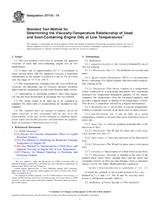We need your consent to use the individual data so that you can see information about your interests, among other things. Click "OK" to give your consent.
ASTM D7110-14
Standard Test Method for Determining the Viscosity-Temperature Relationship of Used and Soot-Containing Engine Oils at Low Temperatures
STANDARD published on 1.12.2014
The information about the standard:
Designation standards: ASTM D7110-14
Note: WITHDRAWN
Publication date standards: 1.12.2014
SKU: NS-37582
The number of pages: 8
Approximate weight : 24 g (0.05 lbs)
Country: American technical standard
Category: Technical standards ASTM
Annotation of standard text ASTM D7110-14 :
Keywords:
borderline pumping temperature, critical pumpability temperature, critical pumpability viscosity, engine oil, gelation, Gelation Index, Gelation Index Temperature, low-temperature engine oil pumpability, low-temperature rheology, Scanning Brookfield technique, sooted oils, temperature-scanning technique, used oils, viscosity,, ICS Number Code 75.100 (Lubricants, industrial oils and related products)
Additional information
| Significance and Use | ||||||||
|
5.1 Significance of Low Temperature, Low Shear Rate, Engine Oil Rheology—The low-temperature, low-shear viscometric behavior of an engine oil, whether new, used, or sooted, determines whether the oil will flow to the sump inlet screen, then to the oil pump, then to the sites in the engine requiring lubrication in sufficient quantity to prevent engine damage immediately or ultimately after cold temperature starting. Two forms of flow problems have been identified,3 flow-limited and air-binding behavior. The first form of flow restriction, flow-limited behavior, is associated with the oil's viscosity; the second, air-binding behavior, is associated with gelation. 5.2 Significance of the Test Method—The temperature-scanning technique employed by this test method was designed to determine the susceptibility of the engine oil to flow-limited and air-binding response to slow cooling conditions by providing continuous information on the rheological condition of the oil over the temperature range of use.3,4,5 In this way, both viscometric and gelation response are obtained in one test. Note 1: This test method is one of three related to
pumpability related problems. Measurement of low-temperature
viscosity by the two other pumpability test methods, D3829 and D4684, hold the sample in a quiescent
state and generate the apparent viscosity of the sample at shear
rates ranging up to 15 s-1 and shear stresses up to
525 Pa at a previously selected temperature. Such difference in
test parameters (shear rate, shear stress, sample motion,
temperature scanning, and so forth) can lead to differences in the
measured apparent viscosity among these methods with some test
oils, particularly when other rheological factors associated with
gelation are present. In addition, the three methods differ
considerably in cooling rates.
5.3 Gelation Index and Gelation Index Temperature—This test method has been further developed to yield parameters called the Gelation Index and Gelation Index Temperature. The first parameter is a measure of the maximum rate of torque increase caused by the rheological response of the oil as the oil is cooled slowly. The second parameter is the temperature at which the Gelation Index occurs. |
||||||||
| 1. Scope | ||||||||
|
1.1 This test method covers how to measure the apparent viscosity of used and soot-containing engine oils at low temperatures. 1.2 A shear rate of approximately 0.2 s-1 is produced at shear stresses below 200 Pa. Apparent viscosity is measured continuously as the sample is cooled at a rate of 3°C per hour over the range of −5 °C to −40 °C. 1.3 The measurements resulting from this test method are viscosity, the maximum rate of viscosity increase (Gelation Index) and the temperature at which the Gelation Index occurs. 1.4 Applicability to petroleum products other than engine oils has not been determined in preparing this test method. 1.5 The values stated in SI units are to be regarded as standard. No other units of measurement are included in this standard. 1.6 This standard does not purport to address all of the safety concerns, if any, associated with its use. It is the responsibility of the user of this standard to establish appropriate safety and health practices and determine the applicability of regulatory limitations prior to use. |
||||||||
| 2. Referenced Documents | ||||||||
|
We recommend:
Technical standards updating
Do you want to make sure you use only the valid technical standards?
We can offer you a solution which will provide you a monthly overview concerning the updating of standards which you use.
Would you like to know more? Look at this page.




 Cookies
Cookies
